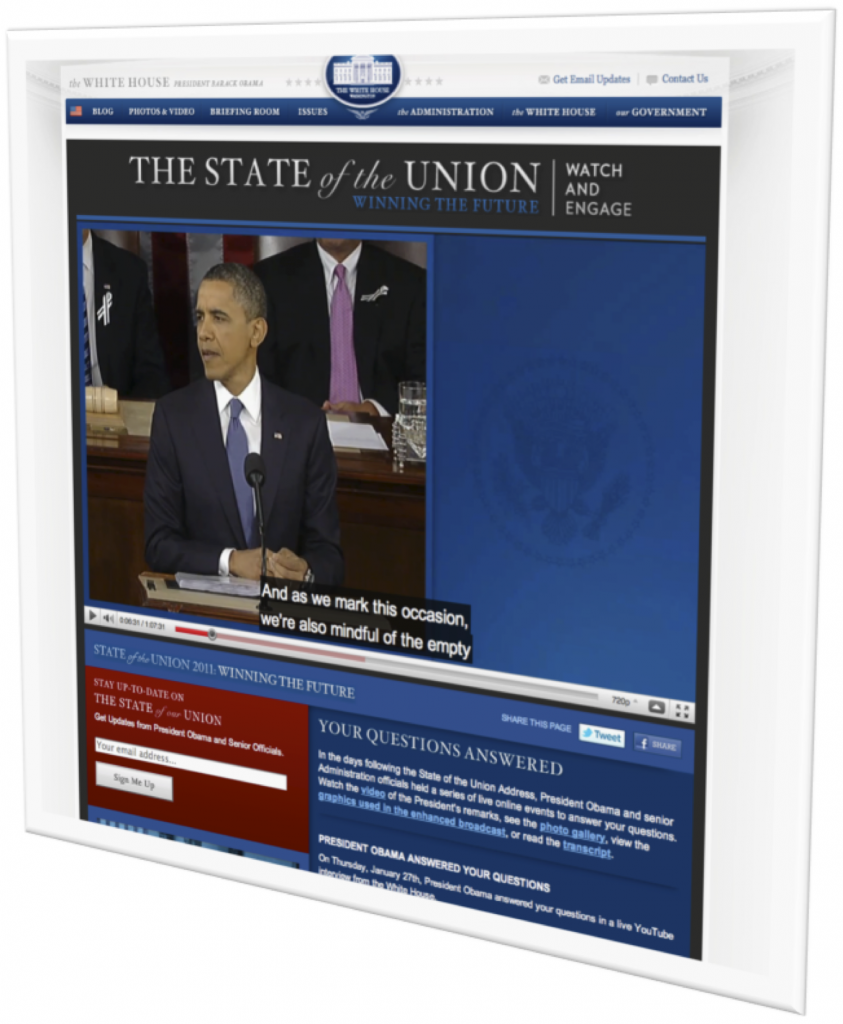 Regardless of what you think of our President’s policies, Barak Obama‘s team is doing an excellent job in its use of media, particularly social media. Technology is enhancing how we communicate our messages and priorities, and the Obama White House has a firm handle on how to do it well. From the first days after his election and as the President-elect, Barak Obama began weekly video addresses (in addition to the old-guard radio address), and a series of video posts from various internal groups working on policy issues. They are always enhancing how they use media to connect with people. Media tends to connect people in a more personal way and not merely in a starched policy manner.
Regardless of what you think of our President’s policies, Barak Obama‘s team is doing an excellent job in its use of media, particularly social media. Technology is enhancing how we communicate our messages and priorities, and the Obama White House has a firm handle on how to do it well. From the first days after his election and as the President-elect, Barak Obama began weekly video addresses (in addition to the old-guard radio address), and a series of video posts from various internal groups working on policy issues. They are always enhancing how they use media to connect with people. Media tends to connect people in a more personal way and not merely in a starched policy manner.
In fact, one of the ways the White House is utilizing media well, is to bring the public inside the secured walls of the White House and show them how people and the process work. An excellent illustration of this was the 2011 State of the Union. In addition to a brief video on how the speech was constructed, the White House, for the first time, included enhanced on-line media (like a power-point presentation), chats, use of Twitter, and live online interviews with the President after the speech. I’ve seen few public sector organizations work this well on connecting people more personally.
State of the Union Video
There is much modern church ministry can learn from the rapid growth of technology. While the message is most important and should be the laser-like focus of leaders and members alike, technology has provided unprecedented ways to publicly broadcast our message. From the use of Twitter and Facebook to quickly inform church members of prayer needs or immediate announcements, to weekly e-mail blasts that can bring the entire church around specific ministry events, to a church’s web-site and publishing its sermons literally across the world, or regular video highlights that may give people insight into a ministry going on in a church of which they had little information about previously.
Media can be a spiritually devastating distraction also. Too many today want quick sound-bites that require little thought and high emotional impact. Yet, God gave us a deep and profound book in which we need to think carefully about and linger long and prayerfully over. Personal, face-to-face conversation is much more important and effective in communicating truth than a mere 140 characters of information or shortened links to more spots on the web. John Piper gave an excellent challenge last week about distracting yourself from your e-reader with a concentration on Bible apps – a conversation that we would not have had ten (maybe even five) years ago. Modern media, like food, money, facilities, old-style print publications, cars, etc., can have a dumbing down effect on how we think and meditate on deep and profound subjects. But it doesn’t have to be that way.
Piper on Technology
How can Christians and local churches make the most of modern media opportunities? I certainly do not have significant answers, but am trying to think significantly about this subject. I am told that I can reach out to 95% of the members of my church in one single e-mail. I am regularly meeting people who have first thoroughly visited our church’s web-site and my personal blog before than have personally visited our church’s worship service. I am amazed at how I can connect people to what goes on in our family in more personal ways. It is facinanting to watch Christians across the globe pray for the release of a persecuted Christian in Afghanastan over the weekend. I am humbled by a group of people who pray for me while I study each week, who I try to keep connected through a weekly e-mail and twitter. I’m amazed that a mission team from our church will be trained by people in Prauge via Skype. I am challenged by how many are following my sermon outline (particularly young children) more significantly by a simple use of power-point slides. I’m thankful that we can now publish the lyrics to each week’s songs on our web-site and allow people to meditate on them before we gather to sing them. The uses go on and on – and we are not even using technology all that well.
What should we beware of? How can utilize it more effectively? Technology is only going to grow and we ordinary pastors and ordinary churches need to act on the opportunities, and deliberately hold ourselves accountable regarding the dangers.
How do you think churches could best leverage technology? What do you think are some of the most subtle dangers to beware of?








Appreciate the post. I learned something new that we are now publishing our slideshows and that the missions team will be training via Skype. Very Cool. thanks for sharing all this information.
It’s almost mind boggling what can be leveraged today that isn’t. But at times it can seem counterproductive because of the time involved in trying to do the leveraging.
—
Bret Capranica
thecapranica.com